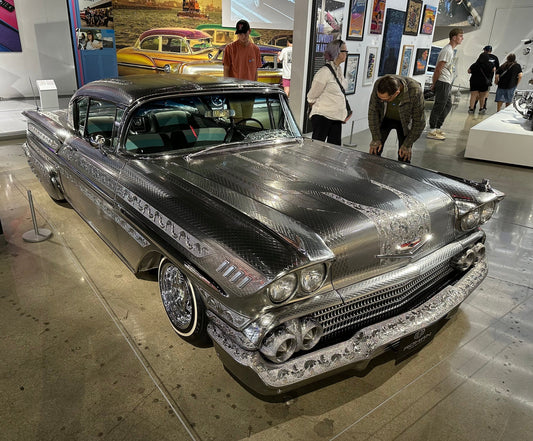We wrapped up our last installment with the end of World War II, the formation of Altec-Lansing after the break-up of Western Electric, and the arrival of permanent magnet drivers (including Alnico). In the US, very little changed in the world of theater horn speakers, where the Altec-Lansing Voice of the Theatre series, based on the work of John Hilliard and Jim Lansing, dominated the market for more than 30 years.
In the world of American home audio of the ’50’s—and for that matter, all the way to the new millennium—the name most closely associated with horn speakers was that of Paul Wilbur Klipsch. Klipsch formed his tiny company Klipsch & Associates in 1946—he was the only employee until 1948, and made every speaker by hand until then. Klipsch’s base of operations, Hope, Arkansas, later became better known as the birthplace of President Bill Clinton.
Klipsch’s most famous creation was a folded corner horn loudspeaker which became known as the Klipschorn. All through the ’50’s, however, dozens of US manufacturers licensed Klipsch patents for folded horn enclosures, and hobbyist publications were filled with ads for “Klipsch patent horn” enclosures and kits.

The first page of a lengthy 1947 article describing the Klipschorn. Apologies for it being askew.
The real deal Klipschorn is still made in Hope, although most other Klipsch products are offshored (which I can’t imagine would thrill Paul, who died in 2002). The enclosures are plywood, meticulously glued and screwed together. During a visit to the factory in 1980, Paul told me, “you can’t use fiberboard—it won’t hold a screw!” That’s less true now than it used to be, thanks to the appearance of many new varieties of screw-threads—but many speaker builders would choose ply over MDF on the basis of sound quality.
But I digress.
Klipsch’s patent described a front-loaded horn, with a difference. If you look at a pair of K-horns from a listening chair, you won’t see any evidence of a woofer. The interior of the enclosure features the front of the woofer—facing the listener—firing into a void which defines a section of a horn which then folds backwards, with sound coming out from the rear, loading the corner of the room and using the walls to define the rest of the horn. The need for corner placement obviously limits options available to users, but it it is absolutely necessary in order for the speaker to function properly, and couple to the room. During my visit to the factory, I was amused to see a full-sized anechoic chamber—with a built-in reflective corner to allow usage and testing of the K-horns.
Elsewhere, after five frequently contentious years, Jim Lansing left Altec-Lansing and founded a new company, Lansing Sound, Incorporated, in 1946. Lansing’s former partners at Altec-Lansing objected to the company name, which was then changed to James B. Lansing Sound. In 1949, Lansing killed himself, apparently distraught over business losses. The company treasurer, William Thomas took over management of the company and, following continued pressure from Altec-Lansing, changed the company name to JBL.
According to an excellent piece on the Lansing Heritage website (which is always an invaluable resource for anyone interested in the history of American audio), the popularity of the Klipsch corner horn caused JBL dealers to pressure the factory for something similar. The result was the Hartsfield, named after its designer, Bill Hartsfield. The unique appearance, noteworthy performance, and high price ($726-$735 in the mid-’50’s, or about $6700 today) put the small company on the map. The resultant Hollywood associations only served to increase the brand’s luster, and emphasize the Hartsfield as a halo product, and JBL as a provider of the best of the best.
 As the ’50’s progressed, smaller speakers like the acoustic suspension designs produced by AR and KLH became commonplace, and big horn speakers became the domain of extreme hobbyists, even more than before. Audio, electronics, and home-project magazines like Popular Mechanix often featured speaker construction projects, many of which were built-in designs. An extreme example of such a project was the “Concrete Monster”, featured in Audio magazine in Audio magazine in 1954. A California homeowner basically buried a woofer in a steel drum in his yard and loaded the woofer with an exponential horn that he built out of concrete, the output going into his living room. Mid- and tweeter-horns in the living room completed the system. Even 60+ years later, the “Monster” is still fondly remembered as a quirky example of an extreme home-built speaker system. Finding a corner or a spot for one big horn speaker is tough enough. With the advent of a stereo, home hi-fi enthusiasts were faced with the necessity of finding room for two big speakers. While bookshelf speakers dominated the domestic hi-fi scene, a few big boys survived into the ’60’s (and in some cases, well beyond). Several, like the ElectroVoice Patrician and Bozak Concert Grands, were infinite baffles; among the few remaining home horn systems were the Klipschorn, the JBL Paragon and the Altec Laguna. Rarely seen these days, the Laguna was a corner horn based upon Voice of the Theatre components. At $585 per speaker in 1962 ($1170 for a stereo pair), the Lagunas were rare birds indeed; adjusting for inflation, a pair would be over $9,500 in 2017 dollars.
As the ’50’s progressed, smaller speakers like the acoustic suspension designs produced by AR and KLH became commonplace, and big horn speakers became the domain of extreme hobbyists, even more than before. Audio, electronics, and home-project magazines like Popular Mechanix often featured speaker construction projects, many of which were built-in designs. An extreme example of such a project was the “Concrete Monster”, featured in Audio magazine in Audio magazine in 1954. A California homeowner basically buried a woofer in a steel drum in his yard and loaded the woofer with an exponential horn that he built out of concrete, the output going into his living room. Mid- and tweeter-horns in the living room completed the system. Even 60+ years later, the “Monster” is still fondly remembered as a quirky example of an extreme home-built speaker system. Finding a corner or a spot for one big horn speaker is tough enough. With the advent of a stereo, home hi-fi enthusiasts were faced with the necessity of finding room for two big speakers. While bookshelf speakers dominated the domestic hi-fi scene, a few big boys survived into the ’60’s (and in some cases, well beyond). Several, like the ElectroVoice Patrician and Bozak Concert Grands, were infinite baffles; among the few remaining home horn systems were the Klipschorn, the JBL Paragon and the Altec Laguna. Rarely seen these days, the Laguna was a corner horn based upon Voice of the Theatre components. At $585 per speaker in 1962 ($1170 for a stereo pair), the Lagunas were rare birds indeed; adjusting for inflation, a pair would be over $9,500 in 2017 dollars.
While the Lagunas were only around for a few years, the Paragon was around from 1967 to 1983, and took the place of the Hartsfield as the “dream speaker” of mainstream media. In the ’50’s and ’60’s, both Altec and JBL featured styling that we would call “mid-century modern” these days, with Scandinavian-influenced rounded, organic forms and lots and lots of wood. The king of such styling was without a doubt Arnold Wolf’s Paragon, a one-piece stereo credenza over eight feet long. Many found—as I did—that the Paragon’s appearance was more beguiling than its sound.
By the time I got into audio in the early ’70’s, horns were nowhere to be found in home hi-fis. The Klipschorn and Paragon existed in an ethereal realm of ultimate products beloved of mainstream media but very rarely seen. During the era when Quads were still revered and LS3/5A, Magnepan, and Infinity were coming on the scene, audiophiles regarded horns as obsolete: dinosaurs. The virtues of high efficiency were largely lost upon fanboys saving their pennies for the Phase Linear 700 or other high-power amplifiers.
The only areas where horns still ruled were sound reinforcement, PA systems and theater systems. The Voice of the Theatre systems laid out by Lansing and Shearer in 1945 (shown in last issue‘s installment) just kept going and going, on to the new millennium.
But something funny happened. Starting in the late ’60’s (and possibly even earlier), a group of ardent audiophiles in Japan latched on to vintage American horns, especially those from Western Electric. By the time I read about the culture in one of Paul Messenger’s “Subjective Sounds” columns in a 1976 issue of Hi-Fi News, numerous brands of ultra-fi horns and compression drivers had sprung up in Japan, supported by makes of ultra-fi tube amps of what seemed to American sensibilities to be absurdly low output: 2A3 amps of 2 watts? Others, with fractional-watt output? In the land of mini-watts, the 7-watt WE 300B triode was the giant.
If we think of mainstream audiophiles (an oxymoron?) as “the underground”, these horn-and-triode fans were the sub-sub-basement. The culture spread to France, largely due to Jean Hiraga, and traveled outward from there. By the time the ’80’s came around, there were stirrings amongst horn-fans stateside; by the ’90’s and the arrival of some online communication, they were a pretty well-defined and extremely vocal community.
In the next issue we’ll look at the rebirth of horns in America and the rest of the world, and ponder where we are now.



